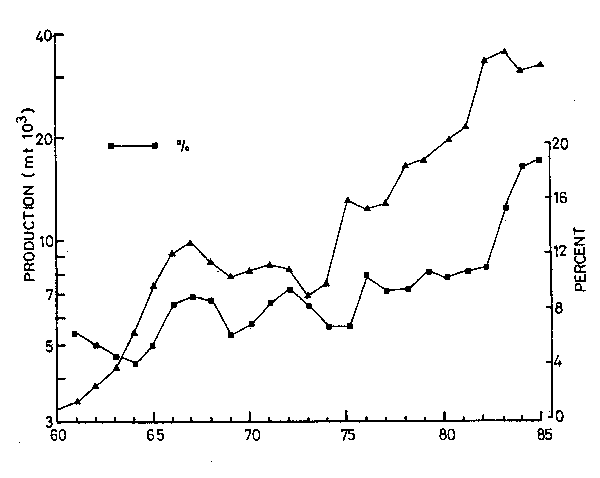The inland fishery in Sri Lanka is a relatively recent development. Fernando and Indrasena (1969) and later on Fernando (1977), Mendis (1977) and De Silva (1983) amongst others dealt with aspects of the inland fishery, which is essentially a capture fishery. At present the inland fishery of Sri Lanka is unique in that it is a fishery confined to man-made lakes and is essentially dependent on a single exotic introduced species, the cichlid Oreochromis mossambicus.
The inland fishery at present accounts for about 20% of the total fish production in the island (Fig.11). The fishery has been on the incline since its establishment, and its importance is likely to grow further with the decline in the deep-sea fishery, and in the coastal fishery in some areas. Apart from these factors a concerted effort is being made to uplift the inland capture and the culture fisheries.
In Sri Lanka, there is no riverine commercial fishery. Most riverine fisheries in the tropics are generally confined to the floodplains (Welcomme, 1976) and the lack of extensive floodplains and the rapid flow of rivers over steep gradients in Sri Lanka prevent or minimise the establishment of fish populations of fishable magnitude.
The number of freshwater fish species indigenous to this country as cited by different authors is between 51 and 55. It has to be accepted that Sri Lanka, although a continental island, has a relatively depauperate fish fauna, and the likely reasons for this have been discussed by De Silva (1985).
Fernando and Indrasena (1969) listed 12 freshwater food fish species. It is now known that of these 12 only Labeo dussumieri and Barbus sarana are of commercial importance and that most of the carnivorous species listed by Fernando and Indrasena (1969) do not form a significant proportion of the inland fish catches.

Fig. 11. Inland fish production and its percentage contribution to the total fish production in the island (modified after De Silva, 1987).
Since the first introduction of Salmo trutta in 1898, further 19 species of true exotics and two estuarine transplants have been added to the inland fish fauna (Table 13). These introductions do not include pet-fish or aquarium species which have been introduced into the country and for which proper records are hard to come by. Sri Lanka perhaps has been lucky, at least until now in that no significant detrimental effects caused by any of these introductions have been observed, either to the indigenous fish fauna or to the aquatic flora and fauna in general. However, this is no reason to be complacent and carry on with further unplanned introductions. Sri Lanka may also be very close to an ecological backlash if introductions continue to be made as advocated, at times, by personnel who are mostly concerned with a single water body and its development. It is clear from the earlier sections that in this island no water body is isolated and stands out on its own.
On the other hand, Sri Lanka stands out as a classic example of a proven success of an exotic finfish species, i.e. Oreochromis mossambicus, on which a whole fishery has become established.